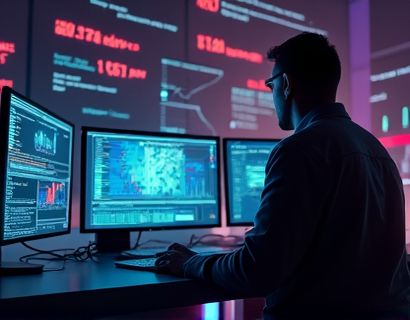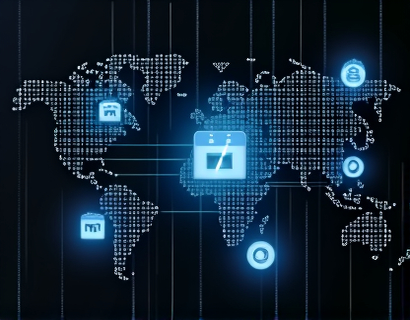Blockchain-Powered Real-World Asset Tokenization: Unlocking Enhanced Liquidity and Market Accessibility
Blockchain technology is at the forefront of transforming traditional asset management by enabling the tokenization of real-world assets. This innovative approach not only enhances liquidity but also broadens market accessibility, offering a secure and transparent environment for asset holders and investors. The integration of physical assets into the digital ecosystem through blockchain provides a robust framework for efficient and trustworthy transactions.
The concept of tokenization involves representing real-world assets, such as real estate, art, and infrastructure, as digital tokens on a blockchain. These tokens are unique digital representations that mirror the properties and rights associated with the underlying asset. By converting tangible assets into tokens, owners can benefit from increased liquidity, as these tokens can be easily bought, sold, or traded on various platforms.
One of the primary advantages of blockchain-powered asset tokenization is the enhancement of liquidity. Traditional real-world assets are often illiquid due to their size, complexity, and the cumbersome processes involved in buying and selling them. Tokenization simplifies these processes by allowing assets to be divided into smaller, more manageable units, making them accessible to a wider range of investors. This increased liquidity attracts more participants to the market, driving activity and efficiency.
Market accessibility is another significant benefit of tokenization. Blockchain technology reduces barriers to entry by lowering transaction costs and eliminating intermediaries. Investors can now participate in the market with minimal capital requirements, opening up opportunities for retail investors who previously could not afford to invest in high-value assets. This democratization of access fosters a more inclusive and dynamic market environment.
The tokenization process begins with the identification and selection of suitable real-world assets. These assets must have clear ownership, well-defined rights, and a stable value proposition to ensure their suitability for tokenization. Once selected, the asset is digitized through a series of steps, including valuation, legal structuring, and smart contract development. Smart contracts, self-executing contracts with the terms directly written into code, play a crucial role in automating and securing the tokenization process.
Smart contracts ensure that all transactions related to the tokenized asset are transparent, traceable, and immutable. They define the rules and conditions under which the tokens can be issued, traded, and managed. This level of transparency builds trust among market participants, as every transaction is recorded on the blockchain and visible to all stakeholders. The immutability of blockchain records also prevents fraud and disputes, further enhancing the reliability of the system.
For asset holders, tokenization offers several strategic advantages. It allows them to diversify their portfolios by converting illiquid assets into tradable tokens, thereby reducing risk and potentially increasing returns. Tokenized assets can be easily integrated into existing investment strategies, providing a new dimension of asset allocation. Additionally, the global nature of blockchain markets enables asset holders to reach a broader audience, tapping into international markets and investors.
Investors benefit from the enhanced liquidity and accessibility brought about by tokenization. They can now invest in a variety of assets that were previously out of reach due to high entry costs or lack of liquidity. The ability to trade smaller token units also allows for more flexible investment strategies, enabling investors to adjust their positions more readily in response to market conditions. Furthermore, the reduced transaction costs and faster settlement times associated with blockchain transactions make investing in tokenized assets more cost-effective and efficient.
The impact of blockchain-powered asset tokenization extends beyond individual asset holders and investors. It has the potential to transform entire industries by streamlining processes and reducing inefficiencies. For instance, in the real estate sector, tokenization can simplify property transactions, reduce paperwork, and lower transaction costs. In the art market, it can provide a new way to authenticate and verify ownership, combating issues like forgery and fraud. Infrastructure projects can benefit from tokenized funding models, attracting more investors and accelerating project completion.
However, the tokenization of real-world assets is not without challenges. Regulatory frameworks are still evolving, and there is a need for clear guidelines to ensure compliance and protect investors. Issues related to scalability, interoperability, and user experience also need to be addressed to make blockchain-based asset tokenization widely adoptable. Despite these challenges, the potential benefits are significant, and ongoing developments in blockchain technology are steadily overcoming these hurdles.
To illustrate the practical applications of blockchain-powered asset tokenization, consider the case of real estate. Traditional real estate investments often involve complex legal processes, high transaction costs, and limited liquidity. By tokenizing real estate assets, these barriers can be significantly reduced. For example, a commercial property can be divided into multiple tokens, each representing a fraction of the property's value. These tokens can then be traded on a blockchain platform, allowing investors to buy, sell, or lend them with ease. This not only increases the liquidity of the property but also makes it accessible to a broader range of investors.
Another example is the art market, where tokenization can enhance provenance and ownership verification. Artworks can be tokenized, with each token containing detailed information about the artwork's history, authenticity, and ownership records. This transparency reduces the risk of fraud and makes it easier for collectors and investors to verify the legitimacy of their purchases. Additionally, tokenized art can be more easily traded and divided, opening up new possibilities for investment and collection management.
The financial sector is another area where blockchain-powered asset tokenization can drive significant changes. Securitization, the process of pooling various financial assets into tradable securities, can be greatly enhanced through tokenization. By tokenizing these assets, financial institutions can create more liquid and tradable securities, improving market efficiency and access to capital. This can lead to more robust funding options for businesses and individuals, fostering economic growth and innovation.
In the infrastructure sector, tokenization can facilitate better funding and management of large-scale projects. Infrastructure assets, such as bridges, roads, and utilities, can be tokenized to attract a wider range of investors. This not only provides the necessary capital for project development but also allows for more transparent and accountable management, as the tokenization process ensures that all transactions and decisions are recorded on the blockchain.
To fully realize the potential of blockchain-powered asset tokenization, stakeholders across industries must collaborate to develop standardized protocols and best practices. This includes working with regulators to create a supportive legal framework that encourages innovation while protecting investors. Technological advancements, such as improved scalability and interoperability, will also play a crucial role in making blockchain-based solutions more accessible and user-friendly.
In conclusion, blockchain-powered real-world asset tokenization represents a transformative shift in asset management, offering enhanced liquidity, market accessibility, and efficiency. By bridging the gap between physical assets and the digital world, this technology empowers asset holders and investors to unlock new opportunities and drive growth. As the ecosystem continues to evolve, the potential for innovation and value creation remains vast, making blockchain-powered asset tokenization a compelling area of focus for blockchain enthusiasts and asset managers alike.










































